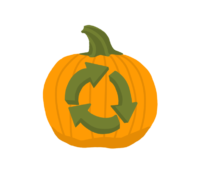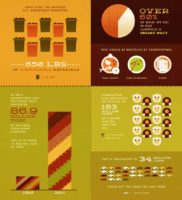“Say what?” My husband looking aloof at my suggestion, “You are going to let our kids smash the pumpkins?”
“I am. And our neighbors’ pumpkins too!”
“Do I get to smash one?”
“Daddy can smash as many pumpkins as he wants!” I tease, smiling at the joy this will bring, seeing their father participate in what is typically a taboo Halloween recreational activity.
“Mom?” Leo, my oldest son, comes running. “Is it time?”
“Almost.” I winked. Leo had been anticipating this for days. “Go get the others.”
Three years ago, when All Hallows Eve had come and gone, and the jack-o’-lanterns still remained, I had an idea. I’m going to let our kids and their friends have a pumpkin bash and responsibly smash our pumpkins into as many pieces as possible –and compost them!
Halloween pumpkins are an excellent opportunity to explore composting!
Learning to compost at an early age creates a better chance that children will continue to do so as adults. Children who learn to conserve nature and help to reduce waste as part of their education are more likely to continue to make sustainable choices independently.
Composting is a sustainable and circular way to live.
 Nature has provided us with a natural way to reuse what we consume and to create renewable energy out of our bi-product known as waste.
Nature has provided us with a natural way to reuse what we consume and to create renewable energy out of our bi-product known as waste.
Composting is a healthier alternative to getting rid of waste.
Pumpkins and jack-o’-lanterns can become compost! Instead of going to a landfill, pumpkins can help reduce our carbon footprint, not add to it!
In a landfill, there is a lack of oxygen, and food-waste cannot decompose naturally. A pumpkin, or any biodegradable waste, decompose much slower, if at all, and emits methane, which is linked to global warming, as it decomposes in landfills.
“Instead, in this dark, anaerobic environment, decomposition happens very slowly, and the food releases far too much methane throughout the process. Deprived of oxygen, the food barely breaks down.” Today’s Landfills
Over time, the waste creates a toxic liquid called leachate and can leak into the surrounding environment, including our farms and freshwater systems. This creates harmful effects to our livelihood, wildlife, and our planet.
Landfills are causing devastation to our eco-systems and to our health.
 According to the EPA, over 36 million tons of food waste reach landfills each year in the United States, and globally, one-third of all food is wasted.
According to the EPA, over 36 million tons of food waste reach landfills each year in the United States, and globally, one-third of all food is wasted.
Food waste that otherwise would have to go to a landfill can be repurposed.
It doesn’t have to go to a landfill – we can choose to compost.
Nature’s way of replenishing itself and returning what came from the earth back to its origin.
Compost is mother nature’s biological lifecycle, natural decay of organic materials that helps to restore soil, conserve water, prevent soil erosion, naturally fertilize plants and vegetation and promote healthy and balanced eco-systems. Through the act of composting, we can reuse organic waste to feed the Earth!
Feed the Earth
Using compost to grow food that we will consume, continues the cycle, and creates a more sustainable and cleaner future. Composting is commonly used in organic-gardening and organic-farming methods and renewable agriculture practices. In fact, organic gardeners and farmers call fresh home-made compost ‘black gold.’
Compost creates optimal growing dirt and helps to level and maintain the amount of water and nutrients that plants need to grow. Plants flourish in conditioned soil that is pH balanced. Compost soil acts as a pH buffer by bringing the pH to a neutral level (a middle ground between acidic and alkaline).
Compost adds nitrogen, phosphorus, and potassium to soil, aids in necessary microbial activity in the soil, attracts beneficial insects such as earthworms, suppresses several soil-borne diseases, and holds its nutrients in an organic or slow-release form.
“Compost is a natural fertilizer that promotes healthier plants, increases drought tolerance and produces more nutritious fruits and vegetables,” said Heather Maybury, Owner of Earth Mama Compost, a local Indianapolis Curbside Compost Company. “When you compost, it ensures the plants grow at an optimal rate, plants will not get as large as they would with the use of synthetic fertilizer, and that’s actually a good thing. Fast growth creates a weak cell structure in plants and makes them more supple to disease. Compost creates vibrant, stronger, more nutrient rich plants.”
Not so spooky!
Pumpkins are smashed, and the aftermath is here! Now, what do I do?
 Smashing pumpkins sounds fun, but the composting part may scare you!
Smashing pumpkins sounds fun, but the composting part may scare you!
Composting is not so spooky!
It’s actually a lot easier then you think, and the alternative?
Dumping the pumpkin in your trash bin, and adding more food waste to our landfills, encouraging more toxins into our air, ground, water — is wayyy spookier!
How To Compost Your Pumpkin
Five Easy At-Home Options:
Have a home compost bin?
Add smashed pumpkin pieces to your home compost bin.
No compost bin?
Freeze your pumpkins! You can freeze your smashed pumpkin in the freezer while you decide the best route to compost!
-
- Freeze in a biodegradable bag (paper or plant-based compostable)
- Save and start a home compost bin in the Spring!
- Look into services of one of Indianapolis’s curbside composting companies.
Local Curbside Composting In Indianapolis:
Curbside compost is easy, convenient, and affordable. Service costs typically range from $5 to 20 for pick-up, depending on quantity and frequency. Weekly, Bi-Weekly, Monthly, Bi-Monthly options available to Indianapolis residents and businesses.
Dig a hole. If your HOA allows, dig a hole somewhere in your yard and bury the pumpkin (or pumpkin pieces.) It will naturally decompose and enrich your soil! This is different from a landfill where the oxygen is scarce! How to do it?
- Bury pumpkin pieces at least 5 inches below the surface.
- Add about an equal amount of fallen leaves.
- Cover hole with dirt
Compost in a bucket! Grab a pail or 5-gallon bucket or pail and fill half-way with ground dirt.
- Add the smashed pumpkin pieces
- Add leaves and cardboard from toilet paper or paper towel rolls
- Add a little water. (Enough to make the soil moist.)
- Stir and chop. Keep it outside. Stir it twice a week.
- In 4 to 5 weeks, your pumpkin pieces will no longer be visible, and you will be left with rich, crumbly compost. Sprinkle the compost in your garden, flower bed, landscape, or yard.
- Note: If using a 5-gallon bucket, poke holes in the top of the lid so that it can breathe.
- Note: If using a pail, or have no lid, then be sure to cover during the rain as the bucket will overflow with water and throw off the pH.
Feed the worms! Worms? Did somebody say feed the worms? Red-wrangler worms used in vermi-composting love pumpkins and all types of squash! Consider starting a vermi-compost bin. Investing in red-wrangler worms and a vermi-compost bin is a great activity for families, youth groups, and classrooms.
-
-
- You can purchase red-wrangler worms and vermicomposting bins online or locally.
- VermiComposting services for lawns.
- Local Vermi-Compost Company based in Fishers.
-
Kids Compost Jar Experiment
A composting jar activity is a fun way for kids to learn about compost and watch it in action!
How To Compost In A Jar
Want to help your children make more sustainable choices this Halloween?
Did you know that nearly 600 million Halloween candy wrappers go to landfills each year??
Rubicon Global and TerraCycle are bringing Zero Waste Boxes to the hands of youth and Helping Ninjas has joined efforts! Consider collecting your empty candy wrappers and recycle!
If you are interested in recycling candy wrappers, Helping Ninjas can help! Click here: Trick Or Trash or email: [email protected].
Want to learn more about how to start composting at home?
Helpful links to get you started…
Kids Compost
Composting For Beginners
Home Composting

Source: Fix.com Blog










